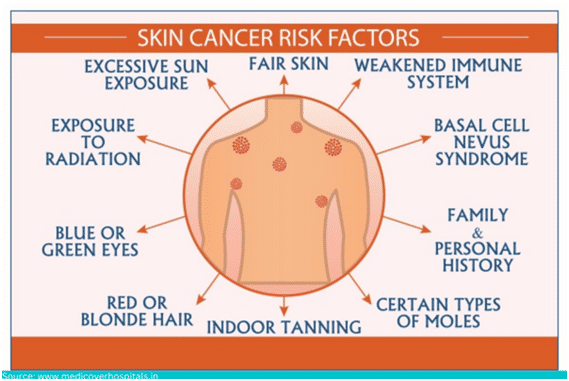People who are fair complexioned, have freckles, blue eyes, and red or blonde hair have a higher risk of developing skin cancer. It is one of the most common forms of cancer in the United States, with more than 3.5 million cases diagnosed each year.
Dr. Leena Jain, a well-known plastic surgeon in Mumbai, says that most cases of skin cancer are treatable, but it is crucial to catch the disease in its early stages.
Earlier, skin cancer was relatively not very common in India. However, the past few decades have seen a slight increase in the incidences of skin cancer occurring in India, with the highest cases detected in the northern parts of India.
According to a recent ICMR (Indian Council of Medical Research) study, melanoma cases are most common in Northern India, and non-melanoma skin cancer cases are most common in Northeast India, particularly in Nagaland.
Types of skin cancer

There are 2 main types of skin cancer: melanoma and non-melanoma.
- Melanoma is the deadliest form of skin cancer, accounting for about 75 % of all skin cancer deaths.
- Non-melanoma skin cancers, such as basal cell carcinoma (BCC) and squamous cell carcinoma (SCC), are much more common, but they are also usually much less aggressive
Melanoma
Melanoma is the most invasive or infiltrating skin cancer and has the highest probability of death. This lethal skin cancer is caused by melanocytes – the cells that produce pigments.
It is characterized by the uncontrolled growth of pigment cells in the skin and can occur in any area of your body but is usually found on the face, neck, and arms.
Despite being a dangerous form of skin cancer, it is treatable if discovered early. Dr. Leena Jain, an eminent plastic surgeon in Bandra, cautions that if left untreated, melanoma can spread to other parts of your body, including your brain and lungs.
Basal cell carcinoma
Basal cell carcinoma is a skin cancer that typically appears as a small, white, or flesh-colored bump on the sun-exposed skin of your face, neck, chest, or back.
Squamous cell carcinoma
Squamous cell carcinoma is a type of cancer that starts in squamous cells. Squamous cells are thin, flat cells that line th and outer surfaces of your body, such as the inside of the mouth or anywhere on the skin or on pre-existing scars. When squamous cell carcinoma starts in the mouth, it is called oral squamous cell carcinoma.
Symptoms of skin cancer
Most skin cancers are found on the skin surface. The first sign is usually a change in the size, shape, color, or feel of the skin.
Other possible symptoms include:
- A mole that changes in size, shape, or color
- A sore that does not heal
- A lump
- A crusty or bleeding sore
- A scaly patch of skin
- A change in the color of the skin
The best way to detect skin cancer is to perform a self-exam every month, looking for any new or changing moles or freckles.
The highly-skilled plastic and trauma surgeon, Dr. Leena Jain, says that if you notice anything suspicious, please make sure that you visit a dermatologist for a biopsy as soon as possible.
Causes of skin cancer

Ultraviolet (UV) radiation from the sun is the leading cause of skin cancer. Other causes include exposure to artificial UV radiation from tanning beds and sunlamps, and having a weakened immune system.
Individuals with fair skin, blue or green eyes, and red or blond hair are at the highest risk of developing melanoma. People with a history of sunburns are also at increased risk. People with a family history of melanoma and exposure to certain chemicals may also have a higher risk to developing skin cancer.
Diagnosis
The dermatologist usually starts by inquiring about any changes you have seen in any moles, freckles, or other skin lesions already present in your body, as well as any new skin growths. They will then examine your overall skin, including the skin on your scalp, ears, neck, hands, and feet, between your toes, genitalia, and between and around your buttocks.
A biopsy may be done if any suspicious skin lesion is detected. During a biopsy, a sample of the suspicious tissue is taken and sent to a lab where a pathologist can study it under a microscope. If your skin lesion is skin cancer, your dermatologist will identify it, describe the type you have, and go over your treatment choices.
Treatment
If you develop skin cancer, it can be treated in several ways, depending on the type and stage of the cancer. Skin cancer can be diagnosed in stages ranging from 0 to IV; the higher the stage, the higher the spread of the disease.
Treatment options include surgery and radiation therapy.If the cancer is small and restricted to your skin’s surface alone, a biopsy may occasionally be able to remove all the cancerous tissue. Other typical therapies for skin cancer, whether used alone or in conjunction, include:
Excisional surgery

In this procedure, the cancer is removed along with some healthy skin around it to ensure that no trace of cancer is left behind.
Mohs surgery
With this method, the tumor’s visible, elevated portion is first removed. Then a very thin layer of cancer cells is removed by your surgeon using a scalpel and immediately studied under a microscope. The subsequent layers of cancer cells are removed one by one until the surgeon can detect no more cancer cells under the microscope.
Mohs surgery only removes cancerous tissue to preserve as much surrounding healthy tissue as possible.
This surgery is most frequently used to treat basal and squamous cell malignancies. It is also helpful in treating cancers in areas closest to sensitive or critical cosmetic regions, such as the eyelids, lips, ears, forehead, fingers, scalp, or genitals.
Mumbai’s renowned plastic surgeon, Dr. Leena Jain, says we can take a few simple preventive measures to lower the risk of skin cancer.
Preventive measures
There are a few things you can do to reduce your risk of skin cancer, including:
- Wearing sunscreen with an SPF of at least 30 every day, even on cloudy days
- Seeking shade whenever possible, especially between 10 am and 4 pm when the sun’s rays are the strongest
- Wearing protective clothing, such as long-sleeved shirts, pants, and hats
- Avoiding tanning beds and sunlamps
- Wearing a wide-brimmed hat that shades your head, face, ears, and neck
Please do not hesitate to see a dermatologist if you notice anything suspicious on your skin. Skin cancer is much easier to treat when it is caught early.
Conclusion
There are many different types of skin cancer, and each type has its own characteristics. Some skin cancers are more aggressive than others, and some are more difficult to treat. In contrast to non-pigmented skin malignancies like squamous cell cancer (SCC) and basal cell carcinoma (BCC), melanoma frequently has no symptoms. No wonder it is known as the “silent killer.”

The best way to combat skin cancer is by preventing it in the first place. That means using sunscreen, wearing protective clothing, and avoiding exposure to ultraviolet (UV) rays. Be sure to see a doctor if you notice any changes in your skin. Do not delay by thinking it is a minor infection and will go away on its own. Remember, the most important thing is that skin cancer is curable if caught early.
If you or a loved one suspects skin cancer and are seeking treatment in Mumbai, please visit the proficient plastic surgeon, Dr. Leena Jain, for a safe and reliable treatment.

